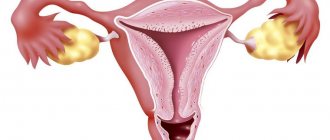Indications for use
Cardiotocography is carried out among women carrying a baby for the purpose of routine examination or in the presence of the following indications:
- Preeclampsia developing in the second half of pregnancy.
- The girl has various diseases (diabetes, hypertension and others).
- The presence of Rh conflict in mother and fetus.
- Prolonged pregnancy.
- Delayed physical development of the fetus.
- Polyhydramnios or oligohydramnios.
- Changes in the child’s behavior in the womb, a sharp increase in the number of movements or their decrease.
The main and main purpose of the study is to record the child’s heart rate.
The heart rate is recorded on the graph in the form of a broken curve, and the resulting graph is called a cardiotocogram in medical practice.
How do you prepare for the examination?
Cardiotocography refers to research methods that allow one to assess the general condition of the child in the womb in a short time. Diagnosis of this type is carried out for the first time from approximately 28 weeks of pregnancy. At later stages, the procedure is often prescribed to determine false or true contractions. How to determine contractions using CTG can only be answered with accuracy by an experienced specialist. Mommy will not be able to decipher the obtained indicators on her own. Cardiotocography does not require any special preparation. A woman should only listen to some simple advice:
- Before starting the procedure, it is recommended to visit the toilet.
- You should not undergo the procedure on an empty stomach. Have a small snack.
- During the diagnosis, try to sit comfortably; you can use a pillow.
- Try not to be nervous, your breathing should be even.
To check the fetal behavior at rest and activity, the doctor may ask you to hold your breath for a few seconds.
Sometimes a woman is asked to perform basic physical exercises, for example, on a fitball. The total duration of the session is usually half an hour.
What is CTG?
Cardiotocograph refers to ultrasound research methods. The results of his research are arranged into a graphic image that is displayed on a paper strip. The method is completely painless, easy to use and extremely informative. Doctors resort to it not only during the period of prenatal diagnosis of the condition of the mother and child, but also during the period when the woman begins real contractions. On CTG, the tape is divided into two halves:
- In its upper part, the number of fetal heart beats per minute is recorded.
- At the bottom, contractions are displayed. If the uterus is at rest, it remains within the lower border. As soon as the uterus contracts, the curve rises.
Based on the results of cardiotocography, the doctor can also diagnose signs of fetal asphyxia, abnormalities in neurology, heart function, or umbilical cord entanglement.
What does CTG show?
Cardiotocography allows you to record the intervals between contractions of the heart muscle of a child in the womb. On paper, the device displays a curved line, along which a specialist can determine whether the fetus has certain health problems.
Before birth, a baby's heart rate should be between approximately 110 and 160 beats per minute.
What does cardiotocography show:
- Heart rate variability is the difference between the basal heart rate and the heart rate fluctuations.
- Basal rhythm is the basic rhythm of the heart muscle, which is assessed after 30 minutes of study.
- Fetal activity.
- Accelerations – acceleration of the heart rate by more than 15 beats per minute for 10 seconds or more.
- Decelerations are a decrease in heart rate by more than 15 beats per minute for 10 seconds or more.
- Contractions of the uterus.
All indicators are assessed comprehensively.
Only an experienced specialist can do this. If certain abnormalities are detected, the doctor may refer the woman for additional examination or prescribe a repeat CTG.
Normal values during the study
In the absence of pathologies in the mother and fetus, the indicators during cardiotocography will be as follows:
- Fetal heart rate is from 110 to 150 beats/min.
- There are no decelerations.
- No more than 2 accelerations in 10 minutes.
- At 30 minutes of the study, 2 jumps should be displayed, which indicate the child’s reaction to external stimuli.
With the help of CTG, you can see training or real contractions. In this case, only a specialist should decipher the results.
How safe is CTG?
Doctors assure that this research method is absolutely safe for both mother and fetus. However, some try to get information in advance about what it is and what contractions look like on CTG. Photos usually do not provide as much information as reviews from experienced mothers. First of all, you should listen to your feelings and changes in the baby’s behavior. Most pregnant women do not attach importance to the fact that at times the uterus begins to harden and at the same time grabs the lower back. These are training fights. Cardiotocography allows you to record not only the contraction, but also how the child feels at this time. This is the most important indicator that describes the importance and feasibility of CTG. In this case, the body experiences less stress than with a conventional ultrasound.
What might affect the study data?
Sometimes during a CTG examination it can give a false result. This is due to some characteristics of women.
Incorrect indicators occur in the presence of such provoking factors:
- The girl has various health problems.
- Entwining the baby's umbilical cord.
- Fetal hyperactivity.
- Placental insufficiency.
- Mommy is taking certain medications.
- A woman has bad habits.
If the device shows incorrect results, after birth the baby will not have any abnormalities. To exclude false indicators, it is recommended that the mother undergo cardiotocography twice in the later stages.
Is it possible to use CTG to 100% understand that real contractions have begun?
So, how can you determine from CTG that labor pains have begun? An experienced specialist may well see that uterine contractions have begun, indicating that labor is approaching. In this case, the device will show them in the form of changes in the graphics. Despite this, first of all, the procedure is carried out to assess the condition of the fetus and identify any deviations in its health.
Cardiotocography shows the nature of uterine contractions, which helps the doctor determine the approach and nature of labor in a woman.
PSP and FIGO
It is important to understand that the essence of the study is not only to find out whether CTG shows contractions, but also to timely establish pathology or signs of its development in the fetus. There are two more criteria for assessing how the baby feels inside the womb:
- PSP is an indicator of the condition of the fetus. A value of less than 1 is considered normal, which indicates the child’s well-being and health. If the numbers are from 1.1 to 2, then for the doctor this is a signal that changes are beginning to occur in the baby’s body that can be influenced. They can be eliminated with quite affordable medications and vitamins. You should be wary if the indicators are from 2.1 to 3, which indicates that the child is experiencing severe discomfort. Perhaps the matter is the entanglement of the umbilical cord, the presence of an intrauterine infection. An unconditional reason for hospitalization, when PSP is more than 3, emergency cesarean section is indicated.
- The FIGO assessment method is more common in Europe and much less common in Russia. Despite this, his results are clearer. For those who want to know how to determine contractions using CTG and more, there are three criteria for the condition of the fetus: normal, questionable, and pathological.
How to determine real contractions using CTG?
The readings from the device help the specialist see whether the woman in labor has uterine contractions (indicating that contractions are beginning), what is the interval between them and their strength. The fluctuations are visible in numbers on a special monitor and a curved line displayed by the device. So, let's find out how contractions are determined by CTG:
- Before the procedure, the initial designations of the woman are entered.
- The specialist records the interval during which there are no contractions of the reproductive organ and the tone of the uterus is not increased.
- To see the contractions, the woman in labor is asked to lie on her side.
- The sensor of the device is attached in the navel area. It is here that the fetal heartbeat can be heard most clearly.
- Using another device, contractions of the uterine walls are recorded. An experienced obstetrician can easily distinguish training contractions from real ones. In this case, the scale on the monitor will have characteristic fluctuations.
The woman in labor is asked to press the button as soon as she feels the baby move. This helps the doctor obtain more accurate data during CTG.
If the cervix dilates too slowly during uterine contractions, the pregnant woman is given an antispasmodic. This does not affect the birth process, but helps to relax the muscle fibers, which leads to faster dilation of the cervix.
False contractions
Above we gave an example of how prenatal contractions begin. However, in obstetrics there is also the concept of false contractions.
False contractions are exactly the same process of contraction of the uterus. However, they do not lead to dilatation of the cervix, therefore they are considered “training”. False contractions can cause the expectant mother to rush to the maternity hospital, although in fact it is not difficult to bring them to light. Firstly, a woman, as a rule, does not experience pain. Secondly, the intervals between “training” contractions are not shortened, and they do not intensify.
Usually, starting from the end of the second trimester, a woman begins to feel uterine contractions, which become stronger and longer as the baby grows. If such contractions do not cause pain or increased discomfort, then this is the absolute norm. Shortly before childbirth, such uterine contractions intensify, gradually developing into real contractions.
How are false contractions displayed on CTG?
Training contractions or Braxton Hicks contractions are named after the famous doctor. Such contractions are usually painless and irregular. Often mothers confuse them with true contractions, but a specialist can easily distinguish them from training contractions by performing cardiotocography. In this case, the doctor will conduct a special test. It evaluates the fetal cardiac activity in comparison with the activity of its movements, its interaction with the mother’s vascular system and the placenta. How does CTG show true contractions in a mother? If high results of interaction are shown, the doctor notes the beginning of true uterine contractions, which indicates that the girl is about to give birth.
Real contractions
During pregnancy, false and true contractions can occur. There are several ways to determine what a woman is really experiencing. Braxton-Hicks (training) contractions occur at the beginning of the third trimester and indicate that in this way the body begins to prepare for the upcoming labor. A pregnant woman may feel her stomach tense at times, but the spasms are painless or cause minor discomfort. Everything returns to normal after taking a warm bath or shower, antispasmodics such as “No-shpa”, “Papaverine”, rest/sleep.
Starting from the 32nd week of pregnancy, a woman can be referred for CTG. What do training contractions look like when the readings are deciphered? Uterine contractions are weakly expressed, doctors note this fact by studying digital indicators. On the tape, the contraction intensity will be below 110 beats per minute. At the same time, a pregnant woman may notice that her baby is showing increased activity.
Why is cardiotocography performed?
At 34, 36, 38 weeks of pregnancy, CTG is prescribed to mothers to assess the condition of the fetus, but sometimes the procedure is also performed to detect contractions before childbirth.
The objectives of the survey are the following:
- Identification of deviations in child development.
- Control of uterine contractions.
- Registration of fetal heart rate.
If a girl is at risk, CTG is performed several times throughout the entire period of pregnancy. When the water has not yet broken, but the device shows contractions of the reproductive organ, there is no reason to worry. Mommy is allowed to rest a little, then the procedure is repeated. It often happens that a girl’s true contractions are detected during the next routine examination. In this case, she needs to go to the hospital.
What changes do CTG show during contractions?
Cardiotocography during pregnancy and during childbirth is different. If a woman has begun labor, contractions on CTG will clearly reflect the rhythm of contraction of the muscle tissue of the reproductive organ.
During contractions, CTG indicators change: fetal motor activity, basal and variable rhythm, acceleration, deceleration, uterine contractions.
A pregnant woman may experience false (training) contractions or natural ones. Based on the results of diagnostic data, a specialist can determine whether labor is actually occurring, or whether the body is just preparing for the birth of a baby.
Often women may experience false contractions
How to distinguish false contractions
The main difference between false contractions and real ones is the lack of dilation of the cervix. When a woman comes to the maternity hospital with a description of the symptoms of childbirth, cardiotocography is required.
False contractions on CTG:
- do not show active uterine contractions;
- fetal activity may be stronger than during childbirth;
- deceleration will be maintained;
- accelerations will be quite frequent.
Despite the fact that a pregnant woman may have mild signs of labor, training contractions are easy to determine on CTG, since the main indicator will be a myometrial contraction frequency of less than 110 beats/min.
How do natural contractions occur?
During real contractions, the woman experiences systematic pain, the baby’s movements coincide with uterine contractions, and the baby’s heart rate increases. Since the manifestation of labor is quite obvious, CTG will determine natural contractions.
During real contractions, the woman feels sharp pain
In cases where contractions (real) are displayed on CTG, the woman needs to prepare for the upcoming birth. If abnormalities are detected, it is CTG that can show serious disorders requiring emergency assistance.
During natural contractions, CTG will show the child’s rapid heartbeat and periodic contractions of the reproductive organ. The higher the lines rise on the graph, the more active the birth process is.
Decoding the results
As already mentioned, only a specialist should decipher the results. It is important to remember that the data taken during pregnancy and when true contractions occur differ significantly. First of all, the obstetrician-gynecologist takes into account such an indicator as heart rate. In this case, its average values are recorded. This is called the basal rhythm.
Read more about true and false contractions in our article. Only reliable information for you.
Normally, the baby’s heartbeat should be 110-160 beats per minute. A baby's heart rate can change every second. During the study, you can see small teeth on the paper scale, which are called oscillations. Their amplitude allows us to determine how the heart rate changes at different periods of time.
The following parameters are recorded on CTG:
- Accelerations.
- Decelerations.
The first indicates an increase in heart rate. In this case, only those indicators are taken if the rhythm increases by more than 15 beats in 10 seconds. The second indicator is, on the contrary, a decrease in the fetal heart rate. At the end of the Procedure, all changes are assessed comprehensively and points are assigned.
| Points | Assessment of fetal well-being |
| From 8 to 10 | The child is feeling well without any health problems |
| 5-7 | This assessment is given to the baby if abnormalities are identified and additional diagnostic methods need to be used. |
| Less than 4 | This assessment indicates that the child is not feeling well and has certain problems. |
This rating scale is used quite widely in medical practice and is considered reliable. Based on the movements, the doctor can also determine the baby’s condition. If only 1-2 movements are noted in half an hour, the specialist may decide to induce labor.
Normal indicators of baby movements
CTG allows you to identify such important indicators as the baby’s heart rate and movements. Normally, a child should be active at least 6 times within an hour. This is the average. Minor deviations are allowed under certain circumstances. The following factors can affect your baby's activity:
- The emotional state of a woman.
- Child's sleep.
- Mommy's physical activity.
- Eating.
- Features of metabolic processes in the body.
The frequency of movements is assessed by a specialist in combination with other indicators. The device also allows you to record the intensity of contraction of the reproductive organ. If movements are observed too slowly, this may indicate the presence of various pathologies of the central nervous system in the fetus. In severe forms of hypoxia, there is often no movement at all.
Often the reason for the lack of movement is the child's sleep. If there is no movement during the first study, the doctor may prescribe a repeat CTG.








